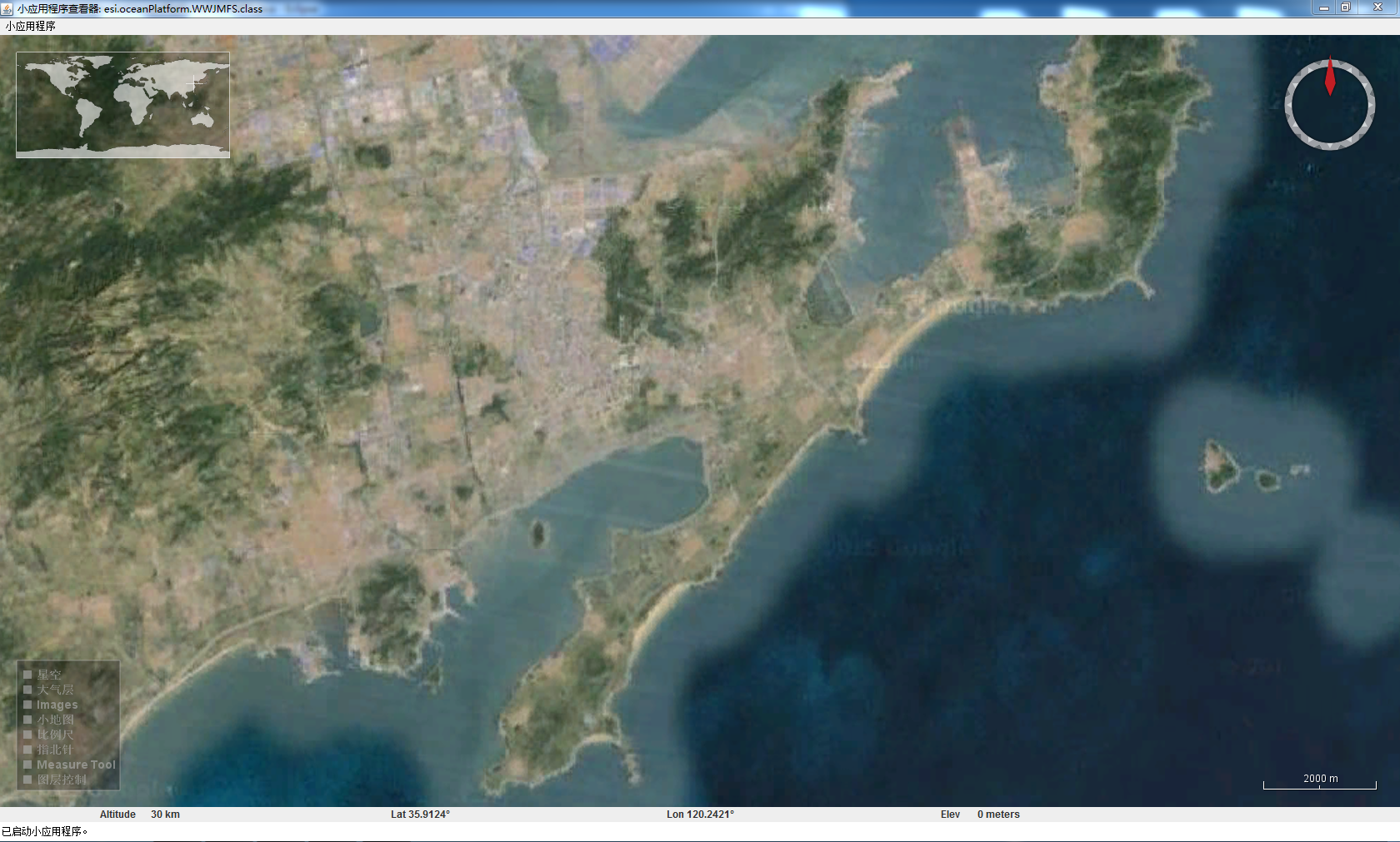我做的项目是在网页中嵌入基于WorldWind的三维地球,所以呢,代码基本是由Java Applet为基准进行编写
本章就开始我们的第一个WorldWind Java Applet
一、新建Java项目WWJMFS
在src文件夹中新建包esi.oceanPlatform,在包中新建Class文件WWJMFS.java。
在WorldWindJava源码中,我们在包gov.nasa.worldwindx.examples.applet中可以看到NASA提供的两个Applet示例,我们鉴于此构建我们的Applet。
详细代码如下:
package esi.oceanPlatform;
import java.awt.BorderLayout;
import java.awt.Cursor;
import java.awt.Panel;
import java.beans.PropertyChangeEvent;
import java.beans.PropertyChangeListener;
import java.util.ArrayList;
import esi.control.FlatWorldPanel;
import esi.control.MeasureToolPanel;
import gov.nasa.worldwind.Configuration;
import gov.nasa.worldwind.Model;
import gov.nasa.worldwind.WorldWind;
import gov.nasa.worldwind.WorldWindow;
import gov.nasa.worldwind.avlist.AVKey;
import gov.nasa.worldwind.awt.WorldWindowGLCanvas;
import gov.nasa.worldwind.geom.Angle;
import gov.nasa.worldwind.geom.LatLon;
import gov.nasa.worldwind.geom.Position;
import gov.nasa.worldwind.layers.Layer;
import gov.nasa.worldwind.layers.LayerList;
import gov.nasa.worldwind.layers.WorldMapLayer;
import gov.nasa.worldwind.util.StatusBar;
import gov.nasa.worldwind.util.measure.MeasureTool;
import gov.nasa.worldwind.util.measure.MeasureToolController;
import gov.nasa.worldwind.view.orbit.BasicOrbitView;
import gov.nasa.worldwind.view.orbit.OrbitView;
import gov.nasa.worldwindx.examples.ClickAndGoSelectListener;
import gov.nasa.worldwindx.examples.util.LayerManagerLayer;
import javax.swing.*;
public class WWJMFS extends JApplet{
protected WorldWindowGLCanvas wwd;
private StatusBar statusBar;
private MeasureToolPanel measureToolPanel;
private PropertyChangeListener measureToolListener;
private MeasureTool measureToolObject;
private FlatWorldPanel flatWorldPanel;
public WWJMFS()
{
}
public void init(){
try
{
// Check for initial configuration values
String value = getParameter("InitialLatitude");
if (value != null)
Configuration.setValue(AVKey.INITIAL_LATITUDE, Double.parseDouble(value));
value = getParameter("InitialLongitude");
if (value != null)
Configuration.setValue(AVKey.INITIAL_LONGITUDE, Double.parseDouble(value));
value = getParameter("InitialAltitude");
if (value != null)
Configuration.setValue(AVKey.INITIAL_ALTITUDE, Double.parseDouble(value));
value = getParameter("InitialHeading");
if (value != null)
Configuration.setValue(AVKey.INITIAL_HEADING, Double.parseDouble(value));
value = getParameter("InitialPitch");
if (value != null)
Configuration.setValue(AVKey.INITIAL_PITCH, Double.parseDouble(value));
// Create World Window canvas.
this.wwd = new WorldWindowGLCanvas();
this.getContentPane().add(this.wwd, BorderLayout.CENTER);
// Create the default model as defined in the current worldwind configuration file.
Model m = (Model) WorldWind.createConfigurationComponent(AVKey.MODEL_CLASS_NAME);
this.wwd.setModel(m);
// Setup a select listener for the worldmap click-and-go feature
this.wwd.addSelectListener(new ClickAndGoSelectListener(this.wwd, WorldMapLayer.class));
//起始定位
try {
InitLocation(35.9501, 120.2133, 30000.0, 0.0, 0.0);
} catch (Exception e) {
System.out.println(e.toString());
}
Panel pageEndPanel=new Panel();
pageEndPanel.setLayout(new BoxLayout(pageEndPanel,BoxLayout.X_AXIS));
//Flat/Round World
flatWorldPanel=new FlatWorldPanel(wwd);
pageEndPanel.add(flatWorldPanel);
this.setFlatWorldVisible(isVisible());
//状态栏
this.wwd.setCursor(new Cursor(0x1));
this.statusBar=new StatusBar();
pageEndPanel.add(this.statusBar);
this.statusBar.setEventSource(wwd);
this.statusBar.setShowNetworkStatus(false);
//测量面板
measureToolObject=new MeasureTool(wwd);
measureToolObject.setController(new MeasureToolController());
measureToolPanel=new MeasureToolPanel(this.wwd, measureToolObject);
measureToolListener=new MeasureToolListener();
switchMeasureTool();
pageEndPanel.add(measureToolPanel);
this.setMeasureToolVisible(isVisible());
this.getContentPane().add(pageEndPanel, BorderLayout.PAGE_END);
LayerManagerLayer layerManagerLayer=new LayerManagerLayer(wwd);
layerManagerLayer.setName("图层控制");
layerManagerLayer.setEnabled(true);
m.getLayers().add(layerManagerLayer);
}
catch (Throwable e)
{
e.printStackTrace();
}
}
public void stop()
{
WorldWind.shutDown();
}
/**
* 插入图层位置
* */
public void insertBeforeLayerName(WorldWindow wwd, Layer layer, String targetName)
{
// Insert the layer into the layer list just before the target layer.
LayerList layers = wwd.getModel().getLayers();
int targetPosition = layers.size() - 1;
for (Layer l : layers)
{
if (l.getName().indexOf(targetName) != -1)
{
targetPosition = layers.indexOf(l);
break;
}
}
layers.add(targetPosition, layer);
}
/**
* 初始图层定位
*/
public void InitLocation ( Double Lat, Double Lon , Double zoom , Double heading , Double patch ){
Position position = new Position(Angle.fromDegrees(Lat), Angle.fromDegrees(Lon),zoom);
this.wwd.getView().setEyePosition(position);
this.wwd.getView().setHeading(Angle.fromDegrees( heading));
this.wwd.getView().setPitch(Angle.fromDegrees(patch));
this.wwd.redraw();
}
/**
* 测量面板
* */
public class MeasureToolListener implements PropertyChangeListener{
public void propertyChange(PropertyChangeEvent event){
if(event.getPropertyName().equals(MeasureTool.EVENT_POSITION_ADD)||event.getPropertyName().equals(MeasureTool.EVENT_POSITION_REMOVE)||event.getPropertyName().equals(MeasureTool.EVENT_POSITION_REPLACE)){
updateProfile(((MeasureTool)event.getSource()));
}
}
}
private void updateProfile(MeasureTool mt){
ArrayList<? extends LatLon>positions=mt.getPositions();
if(positions!=null&&positions.size()>1){
}else{}
this.wwd.redraw();
}
private void switchMeasureTool(){
MeasureTool measureTool=measureToolPanel.getMeasureTool();
measureTool.addPropertyChangeListener(measureToolListener);
updateProfile(measureTool);
}
// ============== Public API - Javascript ======================= //
/**
* 指定经纬度、视野范围、方向定位
*/
public void gotoLatLon(double lat, double lon, double zoom)
{
this.gotoLatLon(lat, lon, zoom, 0.0, 60.0);
}
public void gotoLatLon(double lat, double lon, double zoom, double heading, double pitch)
{
BasicOrbitView view = (BasicOrbitView) wwd.getView();
if (!Double.isNaN(lat) || !Double.isNaN(lon) || !Double.isNaN(zoom))
{
lat = Double.isNaN(lat) ? view.getCenterPosition().getLatitude().degrees : lat;
lon = Double.isNaN(lon) ? view.getCenterPosition().getLongitude().degrees : lon;
zoom = Double.isNaN(zoom) ? view.getZoom() : zoom;
heading = Double.isNaN(heading) ? view.getHeading().degrees : heading;
pitch = Double.isNaN(pitch) ? view.getPitch().degrees : pitch;
view.addPanToAnimator(Position.fromDegrees(lat, lon, 0),
Angle.fromDegrees(heading), Angle.fromDegrees(pitch), zoom, true);
}
}
/**
* 设置视野范围
*/
public void setHeadingAndPitch(double heading, double pitch)
{
BasicOrbitView view = (BasicOrbitView) wwd.getView();
if (!Double.isNaN(heading) || !Double.isNaN(pitch))
{
heading = Double.isNaN(heading) ? view.getHeading().degrees : heading;
pitch = Double.isNaN(pitch) ? view.getPitch().degrees : pitch;
view.addHeadingPitchAnimator(
view.getHeading(), Angle.fromDegrees(heading), view.getPitch(), Angle.fromDegrees(pitch));
}
}
public void setZoom(double zoom)
{
BasicOrbitView view = (BasicOrbitView) wwd.getView();
if (!Double.isNaN(zoom))
{
view.addZoomAnimator(view.getZoom(), zoom);
}
}
/**
* Get the WorldWindowGLCanvas
*/
public WorldWindowGLCanvas getWW()
{
return wwd;
}
/**
* Get the current OrbitView
*/
public OrbitView getOrbitView()
{
if (this.wwd.getView() instanceof OrbitView)
return (OrbitView) this.wwd.getView();
return null;
}
/**
* Get a reference to a layer with part of its name
*/
public Layer getLayerByName(String layerName)
{
for (Layer layer : this.wwd.getModel().getLayers())
{
if (layer.getName().indexOf(layerName) != -1)
return layer;
}
return null;
}
/**
* 显示/隐藏测量面板
*/
public void setMeasureToolVisible ( boolean isVisible){
this.measureToolPanel.setVisible(isVisible);
}
public void setFlatWorldVisible(boolean isVisible) {
this.flatWorldPanel.setVisible(isVisible);
}
}因为我的主要任务是在网页中嵌入三维地球,所以我把上述代码大致分为两块。以
// ============== Public API - Javascript ======================= //
分割
分割线以上部分为球体正常运行所需代码,分割线以下主要去写一些在网页中,通过JavaScript调用函数的接口。
上述代码中仅是比NASA提供的Applet实例多了两个功能,
一个是初始图层定位问题,另一个是测量面板的加载问题,这方面比较简单,就不在进行详解。
二、运行WWJMFS.java可以得到如下图所示
三、本实例中,图层控制面板(左下角)的选择
图层控制面板可以控制各图层的打开关闭,代码如下:
LayerManagerLayer layerManagerLayer=new LayerManagerLayer(wwd);
layerManagerLayer.setName("图层控制");
layerManagerLayer.setEnabled(true);
m.getLayers().add(layerManagerLayer);得到如下图这样
我们看到图中所列这些,可以在WorldWindJava项目中进行更改。
选择src->config->worldwind.layers.xml文件
更改该xml文件如下:
<?xml version="1.0" encoding="UTF-8"?>
<!--
~ Copyright (C) 2012 United States Government as represented by the Administrator of the
~ National Aeronautics and Space Administration.
~ All Rights Reserved.
-->
<!--$Id: worldwind.layers.xml 1382 2013-05-31 00:37:46Z tgaskins $-->
<!--This document specifies the initial layers to load in World Wind-->
<!--This list can be overridden by specifying an alternate list in worldwind.xml, or by specifying an-->
<!--alternate configuration document-->
<!--See the javadoc for the Configuration class for details-->
<LayerList>
<!-- 星空 -->
<Layer className="gov.nasa.worldwind.layers.StarsLayer">
<!--Individual properties can be specified within Layer entries, like this:-->
<Property name="Name" value="星空"/>
</Layer>
<!-- 大气层 -->
<Layer className="gov.nasa.worldwind.layers.SkyGradientLayer">
<Property name="Name" value="大气层"/>
</Layer>
<!-- 默认影像 -->
<!-- <Layer className="gov.nasa.worldwind.layers.Earth.BMNGOneImage">
<Property name="Name" value="NASAIMAGE"/>
<Property name="MinActiveAltitude" value="3e5"/>
</Layer> -->
<!-- 自定义影像 -->
<Layer href="config/Earth/CustomImage.xml" actuate="onLoad">
<Property name="Name" value="Images"></Property>
</Layer>
<!-- 影像 -->
<!-- <Layer href="config/Earth/BMNGWMSLayer2.xml" actuate="onLoad"/>
<Layer href="config/Earth/LandsatI3WMSLayer2.xml" actuate="onLoad"/>
<Layer href="config/Earth/USDANAIPWMSImageLayer.xml" actuate="onRequest"/>
<Layer href="config/Earth/USDANAIPUSGSWMSImageLayer.xml" actuate="onRequest"/>
<Layer href="config/Earth/MSVirtualEarthAerialLayer.xml" actuate="onRequest"/>
<Layer href="config/Earth/BingImagery.xml" actuate="onRequest"/>
<Layer href="config/Earth/USGSTopoLowResLayer.xml" actuate="onRequest"/>
<Layer href="config/Earth/USGSTopoMedResLayer.xml" actuate="onRequest"/>
<Layer href="config/Earth/USGSTopoHighResLayer.xml" actuate="onRequest"/>
<Layer href="config/Earth/USGSUrbanAreaOrthoLayer.xml" actuate="onRequest"/> -->
<!--<Layer className="gov.nasa.worldwind.layers.Earth.OSMMapnikLayer" actuate="onRequest"/>-->
<!--<Layer className="gov.nasa.worldwind.layers.Earth.OSMCycleMapLayer" actuate="onRequest"/>-->
<!-- 官方边界 -->
<!-- <Layer className="gov.nasa.worldwind.layers.Earth.CountryBoundariesLayer" actuate="onRequest"/>-->
<!-- 街道地图 -->
<!-- <Layer href="config/Earth/OpenStreetMap.xml" actuate="onRequest"/> -->
<!-- 夜景 -->
<!-- <Layer href="config/Earth/EarthAtNightLayer.xml" actuate="onRequest"/> -->
<!-- 地名 -->
<!-- <Layer className="gov.nasa.worldwind.layers.Earth.NASAWFSPlaceNameLayer"/> -->
<!-- 小地图 -->
<Layer className="gov.nasa.worldwind.layers.WorldMapLayer">
<Property name="Name" value="小地图"/>
</Layer>
<!-- 比例尺 -->
<Layer className="gov.nasa.worldwind.layers.ScalebarLayer">
<Property name="Name" value="比例尺"/>
</Layer>
<!-- 指北针 -->
<Layer className="gov.nasa.worldwind.layers.CompassLayer">
<Property name="Name" value="指北针"/>
</Layer>
</LayerList>红色字体为注释掉的部分。
其中自定义影像部分以后在进行总结。
本章就到此结束。




























 192
192

 被折叠的 条评论
为什么被折叠?
被折叠的 条评论
为什么被折叠?








